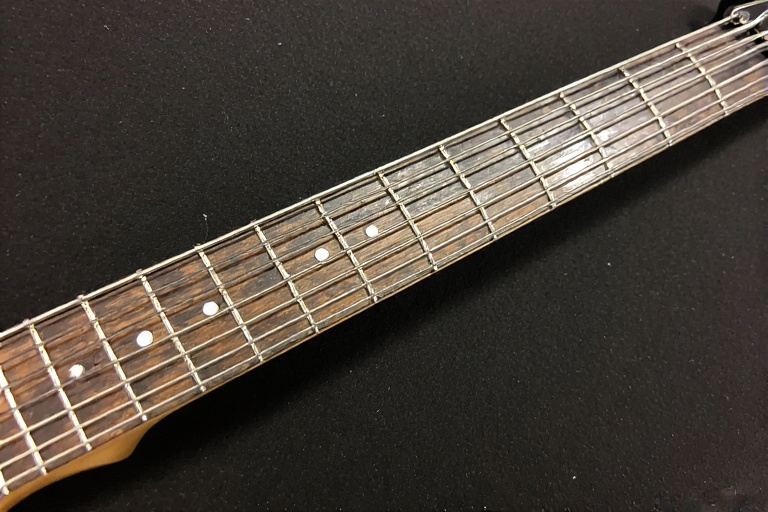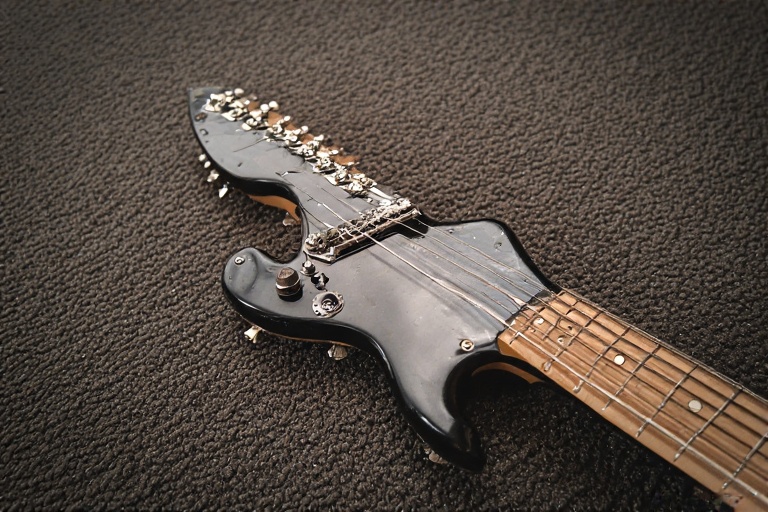The Ibanez JEM series, launched in 1987 as a collaboration with guitar virtuoso Steve Vai, is a cornerstone of modern electric guitar design. Renowned for its bold aesthetics and high-performance capabilities, the JEM is a favorite among shredders and technical players. A key feature is its neck, often described as having “jem necks higher frets are deeper.” This article explores the JEM neck’s design, why its higher frets might feel deeper, and how setup and customizations enhance its playability. Whether you’re a seasoned guitarist or a curious beginner, this guide offers insights into one of the most iconic guitar necks in the world.
The Evolution of the Ibanez JEM Neck
Since its debut, the JEM neck has been engineered for speed and comfort. Steve Vai’s vision was to create a guitar that could handle complex techniques like tapping, sweeping, and rapid legato runs. Consequently, Ibanez developed the JEM neck with a thin profile and a flat fretboard radius, setting it apart from traditional guitars. Over the years, slight refinements have been made, but the core design remains focused on playability and precision.
The original JEM necks were one-piece maple, known for their stability and strength. Newer models, like the JEM7VP, feature a five-piece maple/walnut construction with titanium rods for added durability. These advancements ensure the neck withstands the rigors of aggressive playing while maintaining a smooth, fast feel. This evolution underscores why the JEM neck is celebrated for its unique characteristics, including the perception that “jem necks higher frets are deeper.”

Standard Dimensions of the JEM Neck
To understand the JEM neck’s appeal, let’s examine its standard dimensions, as provided by Ibanez:
| Measurement | Value |
| Thickness at 1st Fret | 19mm (0.75″) |
| Thickness at 12th Fret | 21mm (0.82″) |
| Width at Nut | 43mm (1.7″) |
| Width at Last Fret | 57mm (2.24″) |
| Fretboard Radius | 400mm (15.75″) |
These dimensions make the JEM neck ideal for players who prioritize speed. The slight increase in thickness from the 1st to the 12th fret provides stability without compromising comfort. The flat 400mm fretboard radius facilitates easier chord shapes and smoother transitions, particularly in the higher registers. This design contributes to the perception that “jem necks higher frets are deeper,” as the neck feels more substantial as you move up the fretboard.
What Does “Higher Frets Are Deeper” Mean?
The phrase “jem necks higher frets are deeper” isn’t found in Ibanez’s official documentation, but it likely stems from a combination of design elements and player modifications. Here are the key factors that may explain this perception:
- Neck Profile and Thickness: The JEM neck thickens slightly from 19mm at the first fret to 21mm at the 12th fret. This gradual increase can make the higher frets feel more substantial, as the neck’s profile changes under the player’s hand. This subtle shift might be interpreted as the frets feeling “deeper” in the higher registers.
- Flat Fretboard Radius: With a 400mm (15.75″) fretboard radius, the JEM neck is flatter than many guitars, such as Fenders (9.5″–15″) or Gibsons (12″). A flatter radius makes frets feel more pronounced, as there’s less curvature to the fretboard. This can enhance the sensation that “jem necks higher frets are deeper,” especially for players accustomed to more curved fretboards.
- Scalloping Modifications: Some JEM players scallop their fretboards, particularly in the higher frets (21–24). Scalloping involves removing wood between the frets, creating a concave shape that makes the frets feel taller or “deeper.” This customization, while not standard, is popular among shredders for improving playability in techniques like tapping and fast legato. It’s likely a key contributor to the “deeper” perception.
The All-Access Neck Joint
A standout feature of newer JEM models is the all-access neck joint, which enhances playability in the higher frets. Unlike traditional neck joints, which can obstruct access to the upper registers, the all-access joint is positioned closer to the bridge (around the 17.5th fret compared to the 16th fret on older models). This design reduces bulk, making it easier to reach the highest frets.
While this doesn’t directly make the frets deeper, it improves access and comfort in the higher registers, which might contribute to the perception that “jem necks higher frets are deeper.” The smoother access can make the frets feel more prominent, as players can engage with them more easily.
Comparing JEM Necks to Other Ibanez Models
To fully appreciate the JEM neck, it’s useful to compare it to other Ibanez models, such as the RG series, which also features the Wizard neck profile. The JEM neck is often described as slightly chunkier than the ultra-thin Wizard necks found on some RG models, striking a balance between speed and stability.
| Neck Type | Thickness at 1st Fret | Thickness at 12th Fret | Fretboard Radius |
| JEM | 19mm | 21mm | 400mm (15.75″) |
| Wizard III | 19mm | 21mm | 400mm–430mm |
| Super Wizard | 17mm | 20mm | 430mm |
The JEM neck’s dimensions are similar to the Wizard III but thicker than the Super Wizard, making it more versatile for players who need both speed and control. The flatter fretboard radius of the JEM (400mm) compared to some RG models (up to 430mm) further enhances its suitability for shredding, contributing to the unique feel of its higher frets.
The Role of Fret Size
The JEM series typically uses jumbo frets, which are larger and taller than standard frets. This choice enhances the feel of the frets, particularly in the higher registers where frets are closer together. Jumbo frets provide more surface area for the fingers, making techniques like bending and vibrato easier. However, they require precise fretting to avoid intonation issues.
The larger fret size can make the higher frets feel more pronounced, potentially contributing to the perception that “jem necks higher frets are deeper.” This is especially true when combined with the flat fretboard radius, which minimizes string muting during bends.
Player Modifications and Customizations
Many JEM owners customize their guitars to suit their playing style, with scalloping being a popular modification. Scalloping the fretboard, especially in the higher frets, involves removing wood to create a concave shape between the frets. This reduces the distance the strings need to be pressed, making the frets feel “deeper” and enhancing playability for techniques like tapping and fast runs.
For instance, a player might scallop frets 21–24 to make high-register playing smoother. This customization, while not standard, is common among JEM enthusiasts and directly aligns with the idea that “jem necks higher frets are deeper.” However, scalloping should be done by a professional luthier to avoid damaging the fretboard or affecting intonation.
Importance of Proper Setup
A well-set-up JEM is essential for optimal performance across all 24 frets. Key setup elements include:
- String Action: The distance between the strings and frets should be consistent to prevent buzzing or high action in the higher frets.
- Neck Relief: Adjusting the truss rod ensures the neck has the right curvature for smooth playability.
- Intonation: Proper intonation ensures notes remain in tune across the fretboard.
For players who scallop their fretboards, regular maintenance is crucial. Scalloped areas are more exposed and require careful cleaning to prevent damage. A professional setup can maximize the JEM’s potential, ensuring that the higher frets feel accessible and responsive, aligning with the “jem necks higher frets are deeper” perception.
Player Testimonials
The JEM neck has garnered praise from guitarists worldwide. Steve Vai has noted that the neck’s design allows him to execute complex techniques with ease, from rapid sweeps to expressive bends. Other players echo this sentiment, with one stating, “The JEM neck feels like an extension of my hands. The slight thickening in the higher frets gives it a solid feel without slowing me down.”
Another player shared, “After scalloping the higher frets on my JEM, the playability skyrocketed. It’s like the frets are deeper and more forgiving, perfect for shredding.” These testimonials highlight why the JEM neck is a favorite among technical players.
Custom Shop Options
Ibanez offers custom shop options for players seeking a tailored JEM experience. You can specify neck profiles, fretboard materials (e.g., rosewood, jatoba, or ebony), and fret sizes to create a guitar that matches your preferences. These options allow players to enhance the JEM’s playability, potentially making the higher frets feel even more pronounced or “deeper” through custom fretwork or scalloping.
The Future of JEM Necks
As guitar technology advances, the JEM neck may see further innovations. New materials, such as carbon fiber reinforcements, could make necks lighter and stronger. Manufacturing techniques might allow for even more precise fretboard contours. However, the core principles of the JEM neck—its thin profile, flat radius, and focus on speed—are likely to remain, ensuring it continues to inspire players.
Conclusion
The Ibanez JEM neck is a triumph of design, blending speed, comfort, and precision. The phrase “jem necks higher frets are deeper” likely reflects the neck’s slight thickening, flat fretboard radius, or player modifications like scalloping. These elements, combined with the all-access neck joint and jumbo frets, make the JEM ideal for shredders and technical players. Proper setup and maintenance are key to unlocking its full potential.
Whether you’re a beginner or a seasoned guitarist, the JEM offers a unique playing experience. Explore its features, consider customizations, and ensure a professional setup to make the most of this iconic instrument. Ready to shred like Steve Vai? Check out the Ibanez JEM series and find your perfect guitar today!
FAQs
Q: What is the standard fretboard radius of an Ibanez JEM?
A: The standard fretboard radius for an Ibanez JEM is 400mm (15.75″).
Q: Can I modify my JEM neck to make the higher frets deeper?
A: Yes, scalloping the fretboard in the higher registers can achieve a deeper feel, but it should be done by a professional luthier to avoid damage.
Q: Why is the JEM neck considered fast?
A: The JEM neck’s thin profile and flat 400mm fretboard radius allow for easy navigation and fast playing, ideal for shredding and tapping.
Q: Does the all-access neck joint affect playability?
A: Yes, it improves access to the upper frets, making high-register playing smoother and more comfortable.
Q: Are there different versions of the JEM neck?
A: Yes, Ibanez has made slight variations over the years, but the core design focuses on speed and playability.
